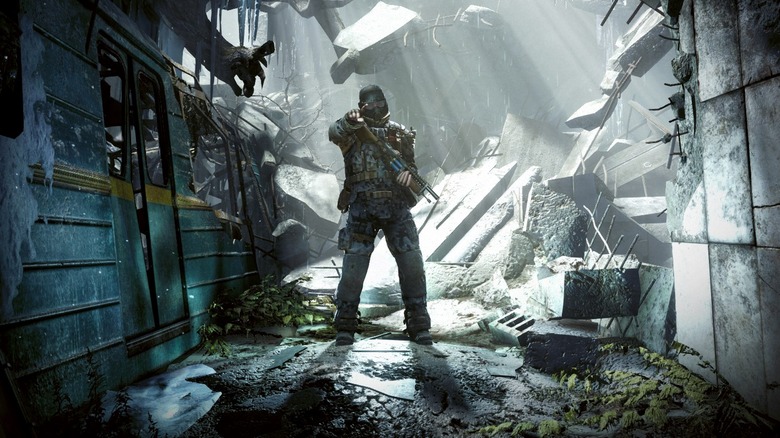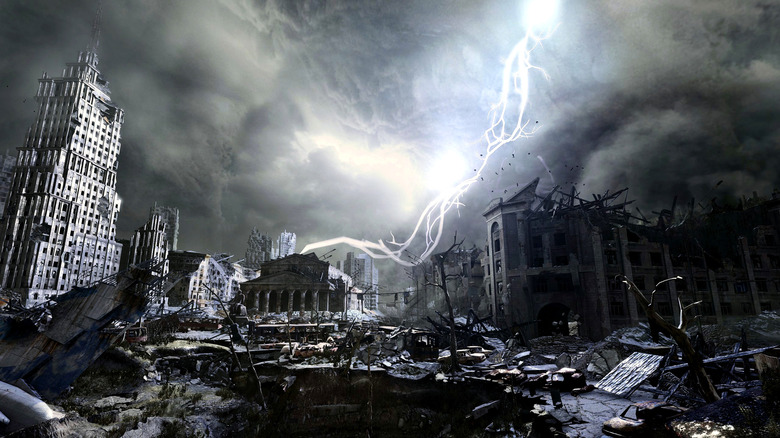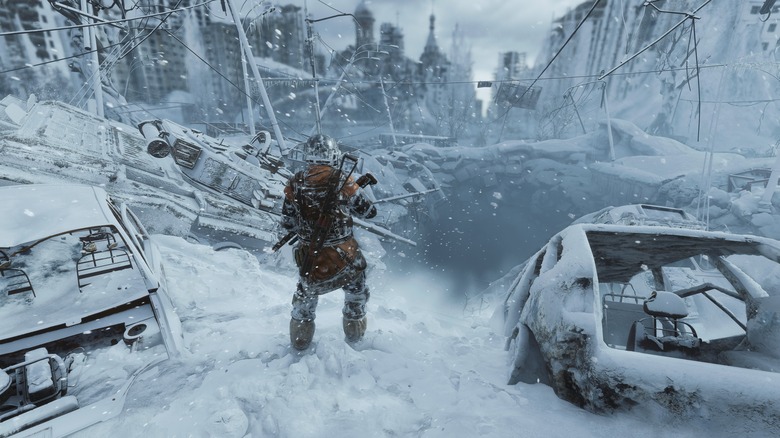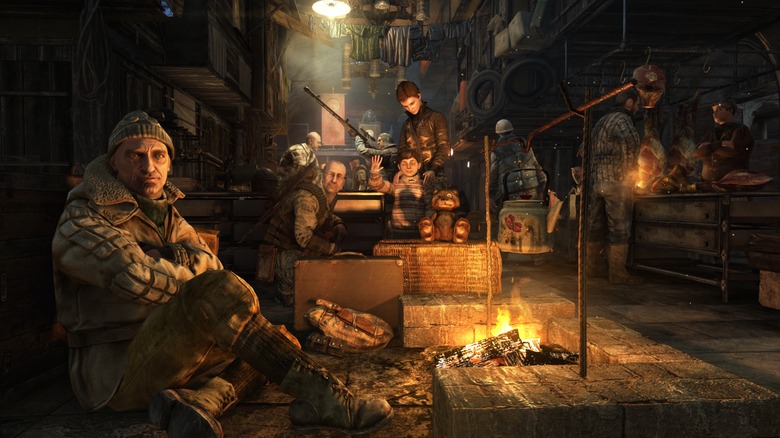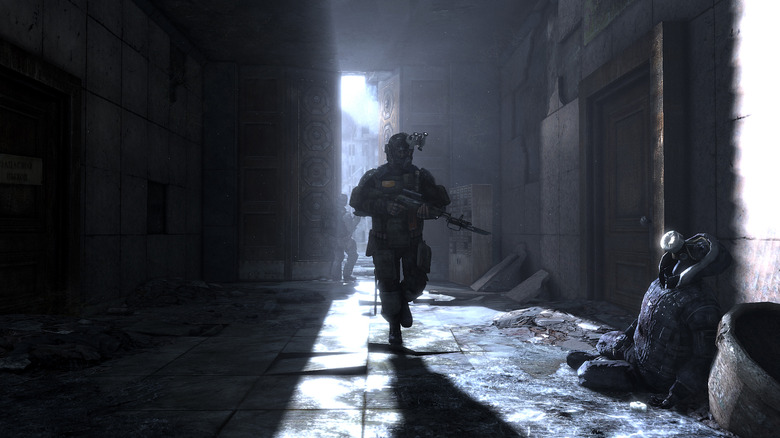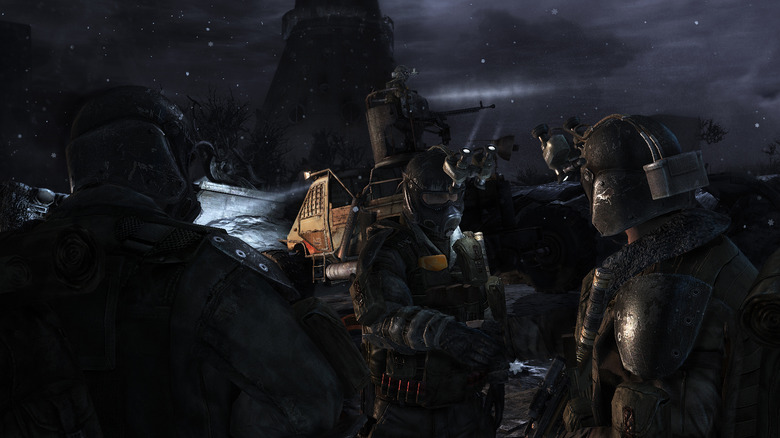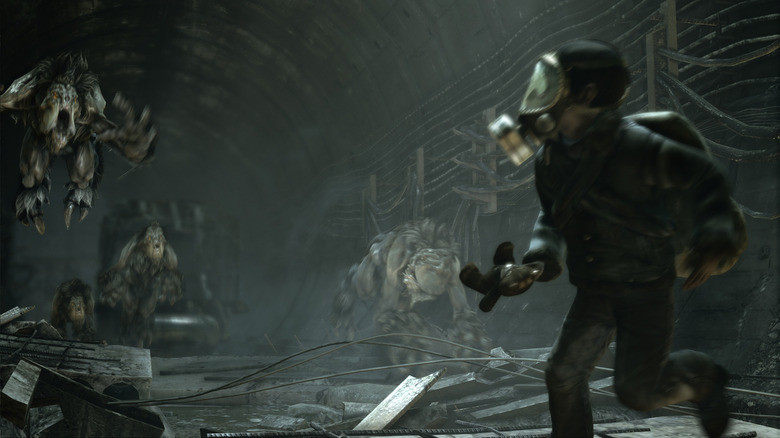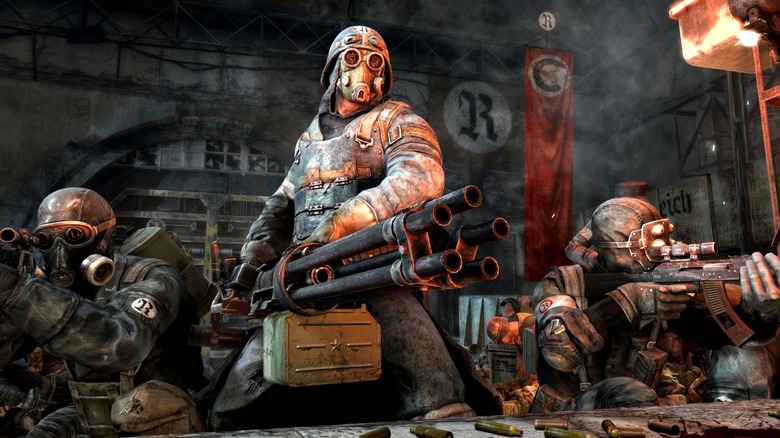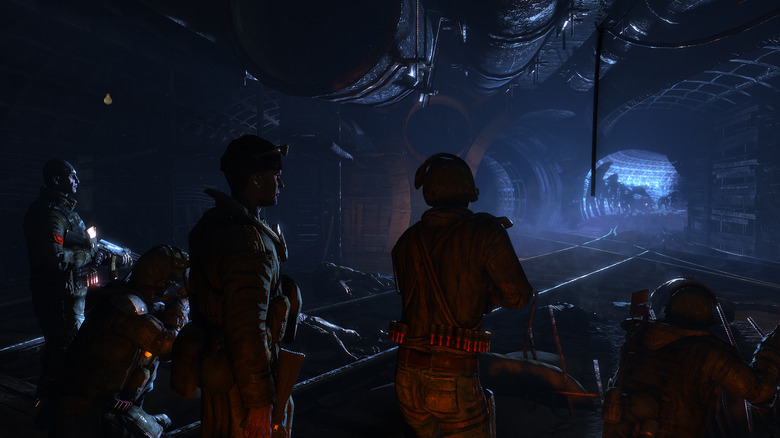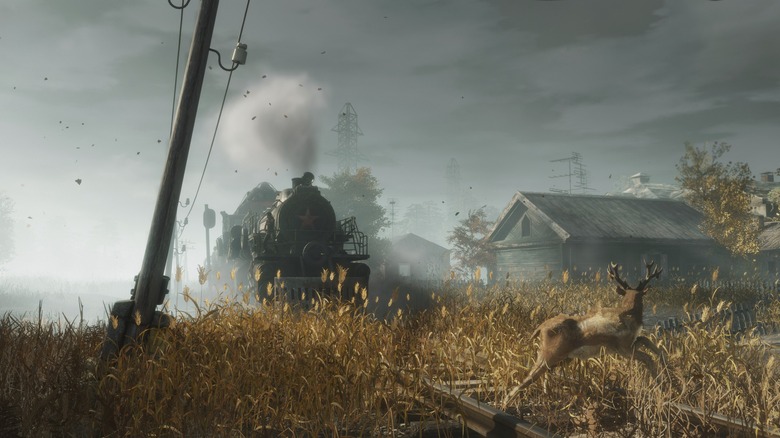The Entire Metro Timeline Explained
The Metro Universe is a franchise inspired by Dmitry Glukhovsky's Metro trilogy of books. The world lies at the intersection of several genres, including post-apocalyptic, horror, fantasy, and science fiction. Glukhovsky consulted on the three game titles developed by 4A games. The setting has spawned a series of short stories, novels, and novellas by a variety of authors. Unlike the original books and the games, these entries are considered only semi-cannon.
The Metro books remain a huge hit in Russia and parts of Eastern Europe, with the success of the games increasing their exposure to Western audiences. Collectively, the original series has sold hundreds of thousands of copies. Though Deep Silver has not released exact sales numbers for the first two games, Metro Redux, an remastered compilation of Metro 2033 and Last Light, had sold over 1.5 million copies as of April 2015. The games have generally been well received, with critics and players praising them for their atmosphere and sympathetic characters.
The world of Metro is a well-developed and refreshing take on the post-apocalyptic genre. Though you have to read the books and play the games to discover the intricate details on offer, here is a rundown of the canonical Metro timeline to-date.
The War of Many Names
Every post-apocalyptic setting requires a cataclysmic event to give it shape. For Metro, the beginning of the end started in the year 2013 with a multi-nation nuclear exchange. Thousands of warheads rained from the sky, resulting in the near annihilation of the human species. This defining event has many names, which vary by location and source. Most commonly, the survivors refer to it as World War III or the Great War of 2013, as it is the largest conflict in history, exceeding the previous world wars in scale. Other monikers include the Conflagration, the Beginning, the Attack, the Catastrophe, and Armageddon.
Details about the war are few and far between, limited by the knowledge of the survivors of the series' primary location: Moscow. At some point during the exchange, a nuclear bomb detonated over the city. Additional attacks hit elsewhere within the country. The blasts killed millions of Russians, with some Russian nuclear submarines launching their payloads in retaliation. Though Russia did not initiate the conflict, it is unclear who struck first, why, and which of the other nuclear-armed nations responded.
Whatever their motivations, each of these countries played a starring role in destroying the planet.
The aftermath
Nuclear winter descended following the Great War. Irradiated material filled the atmosphere, blocking the sun and turning the surface air lethal. Deprived of sunlight and exposed to critical levels of radiation, all flora and fauna went extinct or underwent terrible mutation. Though unconfirmed, some believe millions of people survived the initial detonations but died soon after from radiation or starvation. Like the plants and animals, not all exposure led to death; some humans instead transformed into mutants.
The first Dark Ones may have emerged at this point. These new beings, later referred to as Homo Novus, developed telepathic abilities, resistance to radiation, and extra-sensory perception. They appear connected by a collective hive-mind and, though once human, differ greatly in appearance from their ancestors. It's possible the Dark Ones resulted from genetic experimentation before the war rather than mutation from radiation exposure. This theory, shared by some characters in the series, is never confirmed. Other mutants, such as the snout-nosed Nosalis, also appeared, likely derived from irradiated moles or shrews.
With the games and main book series centered in Moscow, little is known about the fate of the rest of the planet. The death toll and breakdown of infrastructure led to total governmental collapse, though it's possible some leaders may have survived due to nuclear contingencies.
Entries in the Universe of 2033 series reveal the existence of other survivors. Some soldiers survived by taking refuge in their tanks while civilians took shelter in caves or metro tunnels.
The last refuge
Moscow's metro system is the core setting of the franchise, acting as the namesake of the series. Those who survived the Third World War took refuge in the network of underground tunnels, designed to serve as a massive air raid shelter. The Metro houses thousands of people who, cut off from communication with the rest of the world, believe they may be the last remnants of humanity. Composed of a series of subway lines, each station developed its own leader and customs in the years following the war.
Though separated by culture and ideology, the stations all have one thing in common: survival. Under constant threat, all Metro inhabitants struggle against radiation, bandits, and the mutants lurking in the tunnels. According to a note in Metro Last Light, under 50,000 of the original 200,000 survivors are still alive by the time the game takes place.
As the Metro inhabitants sought to reclaim order in their lives, factions developed. Eventually, the stations transitioned into independent states, forging alliances, creating trade routes, and, inevitably, warring with one another over territory and resources.
Three main political systems emerged, with the collection of stations under their influence called "lines." The Red Line is ruled by a Neo-Soviet group of the same name. The Ring Line is led by Hanza, a capitalist democratic group. The Purple Line, which passes through the entire Metro, is less unified, though the Fourth Reich, a Neo-Nazi group, controls four of its main stations.
Opening the door
Before the bomb detonated over Moscow, thousands of Russians rushed to the Metro for shelter. Once the tunnels reached capacity, the entrances were sealed, leaving millions of citizens on the outside to face certain death. Since the Great War, the majority of these entrances, called hermetic doors, have remained sealed. When shut properly, these doors are airtight, preventing radioactivity and other chemical-based dangers from seeping through.
Most stations keep their doors locked to prevent dangers from the surface from gaining access to the Metro. Despite these efforts, mutants and other creatures have still found a way in, taking advantage of unlocked or damaged doors.
Around 2015, the main protagonist of the Metro series, Artyom, and two friends traveled to the abandoned Botanical Garden station. There, they discovered a sealed hermetic door, which the kids opened. Artyom uses the passage to access the surface, where he is discovered and attacked by mutants. During the attack, a Dark One saves Artyom, though he retains no memory of the encounter.
The friends panic and flee, leaving the hermetic door open. Years later, the Dark Ones used this door to enter the Metro, setting the events of Metro 2033 into motion.
Metro 2033
Metro 2033 take place over the course of eight days. Both the game and the book of the same name follow Artyom, a young man born shortly before the Great War, as he and his companions fight to reach Ostankino Tower and wipe out the Dark Ones.
Artyom's journey begins when he and his adopted father, Alex, learn of the new mutant species threatening humanity's survival. Before heading out to face the new enemy, Hunter, a member of an elite group of soldiers called the Spartan Rangers, leaves Artyom his ranger token. Hunter tasks Artyom with taking the token to Miller, another ranger, and delivering a full report if he does not return.
Hunter does not reappear, prompting Artyom to leave his home on a quest to reach Miller at the far-off Polis station. His journey takes him into some of the most dangerous areas of the Metro, where he endures a series of fights, captures, and escapes. With help from various rangers, Artyom scrapes through these encounters, including a tense battle through the front line of a conflict between Nazi and Communist soldiers. After helping the survivors of Hole Station, Artyom reaches the surface and fights his way through Black Station, another Nazi stronghold.
Artyom finally reaches Polis and delivers the token to Miller. With Miller's help, they embark on a mission to uncover the location of an intact launch tower, using the missile guidance system to destroy the Dark One hive.
Metro 2034
Metro 2034 is the sequel to the novel Metro 2033. Though it takes place in Moscow one year after the first book, it follows different characters. Of the two optional endings available in the Metro 2033 video game, both the novels and games assume Artyom wiped out the Dark Ones.
The story begins at the Sevastopolskaya Station, which produces over two-thirds of the Metro's electricity. Due to the location of their generators, the Sevastopolskaya hermetic door must remain open, leaving the station vulnerable to mutant attacks.
To survive the constant onslaught, the station relies on a steady supply of ammunition from the central stations. When deliveries and outside communication suddenly cease, they send several scouting parties to investigate. None of these groups return. Hunter, who assisted Artyom in Metro 2033, volunteers to lead one final mission before they're forced to abandon Sevastopolskaya and head north. Homer, an old Metro technician turned author, and Ahmed accompany Hunter on his quest.
The group discovers that soldiers have locked down the neighboring Tulskaya Station, cutting off access to the tunnel used by the supply caravans. A diary left by a previous expedition reveals that a deadly disease has infected the station.
Detouring through an abandoned metro line, the party heads for the metro center, picking up two more members along the way. Through a series of events, the Tulskaya Station is flooded, killing the infected inside. With the threat removed, trade resumes, preserving the Sevastopolskaya Station, though at a terrible price.
Metro: Last Light
The second entry in the video game series, the events of Last Light take place one year after Metro 2033. Artyom is now a member of the Rangers, who have occupied the military facility used to destroy the Dark Ones. When Khan, a nomadic mystic, visits the D6 facility with news of a surviving Dark One, Colonel Miller sends Artyom to kill the creature. Anna, Miller's daughter and the group's best sniper, accompanies him.
Artyom finds the Dark One, which he discovers is just a child. The pair are then captured by Nazi Reich soldiers. With the help of Red Line soldier Pavel, Artyom escapes the Nazis, only to be taken captive by the Red Line.
Artyom learns of the Red Line's plan to seize D6 and take over the entire Metro system. Assisted by Khan, Artyom rescues the Dark One and, through a series of flashbacks, uncovers that the Dark Ones saved him from mutants as a child. With his memory restored, Artyom determines to protect the Dark One, escorting it back to Polis. While en route, they are confronted by Letnisky, a Ranger traitor, and later Pavel. Using his telepathic abilities, the Dark One reads their minds, uncovering a plot to kill all non-Red Line aligned humans with a bioweapon.
The game has two possible endings, both of which result in the Red Line's defeat. One path leads to Artyom's death; the other reveals the existence of more Dark Ones who come to humanity's rescue.
Metro 2035
Metro 2035, the third installment in the book series, returns to following Artyom in his journeys. In the year that has passed since Metro 2034 and Last Light, the Metro has seen some major changes.
Trying to appear more welcoming, the Fourth Reich has started a series of reforms. An epidemic rendering the Red Line's supply of mushrooms inedible has plunged them into famine. The Rangers, after suffering heavy losses in a bunker battle, has grown closer to Hanza.
Artyom has since left the Rangers, marrying Miller's daughter, Anna. Though they live together in Artyom's home station, VDNKh, a new obsession drives him to the surface several times a week. Convinced he heard a radio transmission at Ostaniko Tower before killing the Dark Ones, he spends much of his time trying to contact survivors outside Moscow. He eventually encounters Homer, who claims he spoke to a radio operator who had contacted survivors in Northern Russia. The two set off to speak with the radio operator.
The operator is killed before Artyom can speak to him. The travelers are soon embroiled in a war between the Fourth Reich and the Red Line, leading to their enslavement by the Nazis.
Artyom eventually uncovers radio signals from several international locations which were being blocked by radio jammers. The novel ends with him and his wife fleeing the Metro via car with what supplies they can get their hands on.
Metro Exodus
Metro Exodus, the third installment in the video game series, takes place in 2036. The story is a continuation of Last Light and 2035, though 4A Games altered some details and characters from the novel. Exodus follows the Redemption ending in Last Light, in which the awakened Dark Ones save humanity by beating the Red Line army.
Rather than leaving via car, Anna and Artyom flee Moscow on the Aurora, a modified train stolen from the Hanza. As they're leaving, the Rangers, led by Miller, converge on the train to retake it. Discovering his daughter on board, the Rangers flee with the couple to escape the Hanza. Miller reveals that NATO took control of the remnants of Russia following the Great War. To discourage their enemies from dropping more bombs on Moscow, the Russian government secretly jammed all radio communications to trick the outside world into believing no one survived the initial bombings.
After receiving a radio broadcast from the Moscow Defense Command calling for survivors to rally at Mount Yamantau, the group travels cross-country via the Trans-Siberian Railway to answer the summons. Upon arrival, they discover the broadcast was a trap set by a cabal of cannibals.
Leaving the mountain, Artyom and his companions set out in search of a safe area to settle. Through a series of trials, including Anna's near-fatal illness, they find a place to call home. Depending on the player's actions, Artyom may live or die at the conclusion of the game.

